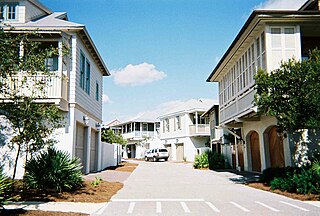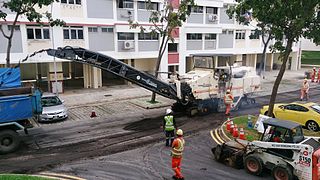Related Research Articles

A tire or tyre is a ring-shaped component that surrounds a wheel's rim to transfer a vehicle's load from the axle through the wheel to the ground and to provide traction on the surface over which the wheel travels. Most tires, such as those for automobiles and bicycles, are pneumatically inflated structures, which also provide a flexible cushion that absorbs shock as the tire rolls over rough features on the surface. Tires provide a footprint, called a contact patch, that is designed to match the weight of the vehicle with the bearing strength of the surface that it rolls over by providing a bearing pressure that will not deform the surface excessively.

A road surface, or pavement, is the durable surface material laid down on an area intended to sustain vehicular or foot traffic, such as a road or walkway. In the past, gravel road surfaces, cobblestone and granite setts were extensively used, but these have mostly been replaced by asphalt or concrete laid on a compacted base course. Asphalt mixtures have been used in pavement construction since the beginning of the 20th century and are of two types: metalled roads and unmetalled roads. Metalled roadways are made to sustain vehicular load and so are usually made on frequently-used roads. Unmetalled roads, also known as gravel roads, are rough and can sustain less weight. Road surfaces are frequently marked to guide traffic.

Soundproofing is any means of reducing the sound pressure with respect to a specified sound source and receptor. There are several basic approaches to reducing sound: increasing the distance between source and receiver, using noise barriers to reflect or absorb the energy of the sound waves, using damping structures such as sound baffles, or using active antinoise sound generators.

Asphalt concrete is a composite material commonly used to surface roads, parking lots, airports, and the core of embankment dams. Asphalt mixtures have been used in pavement construction since the beginning of the twentieth century. It consists of mineral aggregate bound together with asphalt, laid in layers, and compacted. The process was refined and enhanced by Belgian-American inventor Edward De Smedt.

Permeable paving includes a variety of surfacing techniques for roads, parking lots, and pedestrian walkways, unified under the common goal to allow for infiltration of stormwater runoff. Permeable pavement surfaces typically include pervious concrete, porous asphalt, paving stones and interlocking pavers. Unlike traditional impervious paving materials, permeable paving systems allow stormwater to percolate and infiltrate through the pavement and into the aggregate layers and/or soil below. In addition to reducing surface runoff, permeable paving systems can trap suspended solids, thereby filtering pollutants from stormwater. The goal is to control stormwater at the source, reduce runoff and improve water quality by filtering pollutants in the subsurface layers.

Rumble strips are a road safety feature to alert inattentive drivers of potential danger, by causing a tactile vibration and audible rumbling transmitted through the wheels into the vehicle interior. A rumble strip is applied along the direction of travel following an edgeline or centerline, to alert drivers when they drift from their lane. Rumble strips may also be installed in a series across the direction of travel, to warn drivers of a stop or slowdown ahead, or of an approaching danger spot.

Crumb rubber is recycled rubber produced from automotive and truck scrap tires. During the recycling process, steel and tire cord (fluff) are removed, leaving tire rubber with a granular consistency. Continued processing with a granulator or cracker mill, possibly with the aid of cryogenics or by mechanical means, reduces the size of the particles further. The particles are sized and classified based on various criteria including color. The granulate is sized by passing through a screen, the size based on a dimension or mesh. Crumb rubber is often used in artificial turf as cushioning.

Noise control or noise mitigation is a set of strategies to reduce noise pollution or to reduce the impact of that noise, whether outdoors or indoors.

Roadway noise is the collective sound energy emanating from motor vehicles. It consists chiefly of road surface, tire, engine/transmission, aerodynamic, and braking elements. Noise of rolling tires driving on pavement is found to be the biggest contributor of highway noise and increases with higher vehicle speeds.
The Arizona Department of Transportation is an Arizona state government agency charged with facilitating mobility within the state. In addition to managing the state's highway system, the agency is also involved with public transportation and municipal airports. The department was created in 1974 when the state merged the Arizona Highway Department with the Arizona Department of Aeronautics.
Rubber mulch is a type of mulch used in gardens and landscaping that is made from recycled rubber, most often crumb rubber sourced from waste tires.

Chipseal is a pavement surface treatment that combines one or more layer(s) of asphalt with one or more layer(s) of fine aggregate. In the United States, chipseals are typically used on rural roads carrying lower traffic volumes, and the process is often referred to as asphaltic surface treatment. This type of surface has a variety of other names including tar-seal or tarseal, tar and chip, sprayed seal or surface dressing.

Pervious concrete is a special type of concrete with a high porosity used for concrete flatwork applications that allows water from precipitation and other sources to pass directly through, thereby reducing the runoff from a site and allowing groundwater recharge.

Tire recycling, or rubber recycling, is the process of recycling waste tires that are no longer suitable for use on vehicles due to wear or irreparable damage. These tires are a challenging source of waste, due to the large volume produced, the durability of the tires, and the components in the tire that are ecologically problematic.
Road surface textures are deviations from a planar and smooth surface, affecting the vehicle/tyre interaction. Pavement texture is divided into: microtexture with wavelengths from 0 mm to 0.5 millimetres (0.020 in), macrotexture with wavelengths from 0.5 millimetres (0.020 in) to 50 millimetres (2.0 in) and megatexture with wavelengths from 50 millimetres (2.0 in) to 500 millimetres (20 in).
Diamond grinding is a pavement preservation technique that corrects a variety of surface imperfections on both concrete and asphalt concrete pavements. Most often utilized on concrete pavement, diamond grinding is typically performed in conjunction with other concrete pavement preservation (CPP) techniques such as road slab stabilization, full- and partial-depth repair, dowel bar retrofit, cross stitching longitudinal cracks or joints and joint and crack resealing. Diamond grinding restores rideability by removing surface irregularities caused during construction or through repeated traffic loading over time. The immediate effect of diamond grinding is a significant improvement in the smoothness of a pavement. Another important effect of diamond grinding is the considerable increase in surface macrotexture and consequent improvement in skid resistance, noise reduction and safety.
Micronized rubber powder (MRP) is classified as fine, dry, powdered elastomeric crumb rubber in which a significant proportion of particles are less than 100 µm and free of foreign particulates. MRP particle size distributions typically range from 180 µm to 10 µm. Narrower distributions can be achieved depending on the classification technology.
Road ecology is the study of the ecological effects of roads and highways. These effects may include local effects, such as on noise, water pollution, habitat destruction/disturbance and local air quality; and the wider environmental effects of transport such as habitat fragmentation, ecosystem degradation, and climate change from vehicle emissions.

Pavement milling is the process of removing at least part of the surface of a paved area such as a road, bridge, or parking lot. Milling removes anywhere from just enough thickness to level and smooth the surface to a full depth removal. There are a number of different reasons for milling a paved area instead of simply repaving over the existing surface.

The Transportation Research Center (TRC) is North America's largest multi-user automotive proving ground. It is operated by TRC Inc. The center occupies 4,500 acres in East Liberty, Ohio, just 40 miles northwest of Columbus, Ohio. These 4,500 acres are split between the main TRC property and a rural road/ATV course located approximately 2.5 miles from the main property.
References
- ↑ "Management of Scrap Tires". US Environmental Protection Agency.
- ↑ "What is Rubberized Asphalt?". Arizona Department of Transportation.
- ↑ "Silence Please". Associate Construction Publications. Archived from the original on March 19, 2006.
- ↑ "Testing Quieter Asphalt". Associate Construction Publications. Archived from the original on September 24, 2008.
- ↑ "Rubberized Asphalt Comes To Colorado". Associate Construction Publications. Archived from the original on October 19, 2006.
- ↑ In Belgium, tests by Esso Belgium in the ring of Brussel and in the F1 circuit of Francorchamp, belgian film by Jean-Marie Piquint.
- ↑ Hanson, D.I., J.A. Epps, and R.G. Hicks, “Construction Guidelines for Crumb Rubber Modified Hot Mix Asphalt”, Federal Highway Administration Report DTFH61-94-C-00035, August 1996.
- ↑ Jerzy A. Ejsmont (April 8, 2016). "Ultra Low Noise Poroelastic Road Surfaces". MDPI.Cite journal requires
|journal=(help)